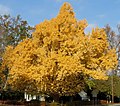ไฟล์:Ginkgo biloba tree in fall colors (Newark, Ohio, USA) (49047727587).jpg

ดูภาพที่มีความละเอียดสูงกว่า (1,772 × 1,560 พิกเซล, ขนาดไฟล์: 2.35 เมกะไบต์, ชนิดไมม์: image/jpeg)
| รูปภาพหรือไฟล์เสียงนี้ ต้นฉบับอยู่ที่ คอมมอนส์ รายละเอียดด้านล่าง เป็นข้อความที่แสดงผลจาก ไฟล์ต้นฉบับในคอมมอนส์
|
ความย่อ
| คำอธิบายGinkgo biloba tree in fall colors (Newark, Ohio, USA) (49047727587).jpg |
Ginkgo biloba Linnaeus, 1771 - maidenhair tree in Ohio, USA. (fall 2014; photo by Mary Ellen St. John) Plants are multicellular, photosynthesizing eucaryotes. Most species occupy terrestrial environments, but they also occur in freshwater and saltwater aquatic environments. The oldest known land plants in the fossil record are Ordovician to Silurian. Land plant body fossils are known in Silurian sedimentary rocks - they are small and simple plants (e.g., Cooksonia). Fossil root traces in paleosol horizons are known in the Ordovician. During the Devonian, the first trees and forests appeared. Earth's initial forestation event occurred during the Middle to Late Paleozoic. Earth's continents have been partly to mostly covered with forests ever since the Late Devonian. Occasional mass extinction events temporarily removed much of Earth's plant ecosystems - this occurred at the Permian-Triassic boundary (251 million years ago) and the Cretaceous-Tertiary boundary (65 million years ago). The most conspicuous group of living plants is the angiosperms, the flowering plants. They first unambiguously appeared in the fossil record during the Cretaceous. They quickly dominated Earth's terrestrial ecosystems, and have dominated ever since. This domination was due to the evolutionary success of flowers, which are structures that greatly aid angiosperm reproduction. Ginkgos do not produce flowers and thus are not angiosperms. Ginkgos are represented by only one living species in the Holocene, but have a fossil record extending back into the Mesozoic and even the Permian. The natural distribution of the living species, Ginkgo biloba, is a few localities in China. It has been extensively cultivated as an ornamental tree and can be found throughout the world. The leaves are fan shaped and can be bilobed. Fall colors are an intense, deep yellow. Classification: Plantae, Ginkgophyta, Ginkgoopsida, Ginkgoales, Ginkgoaceae Locality: neighborhood at the intersection of Mt. Vernon Road and Fairfield Street in Newark, Licking County, east-central Ohio, USA See info. at: <a href="https://en.wikipedia.org/wiki/Ginkgo_biloba" rel="noreferrer nofollow">en.wikipedia.org/wiki/Ginkgo_biloba</a> |
| วันที่ | |
| แหล่งที่มา | Ginkgo biloba tree in fall colors (Newark, Ohio, USA) |
| ผู้สร้างสรรค์ | James St. John |
การอนุญาตใช้สิทธิ
- คุณสามารถ:
- ที่จะแบ่งปัน – ที่จะทำสำเนา แจกจ่าย และส่งงานดังกล่าวต่อไป
- ที่จะเรียบเรียงใหม่ – ที่จะดัดแปลงงานดังกล่าว
- ภายใต้เงื่อนไขต่อไปนี้:
- แสดงที่มา – คุณต้องให้เกียรติเจ้าของงานอย่างเหมาะสม โดยเพิ่มลิงก์ไปยังสัญญาอนุญาต และระบุหากมีการเปลี่ยนแปลง คุณอาจทำเช่นนี้ได้ในรูปแบบใดก็ได้ตามควร แต่ต้องไม่ใช่ในลักษณะที่แนะว่าผู้ให้อนุญาตสนับสนุนคุณหรือการใช้งานของคุณ
| This image was originally posted to Flickr by James St. John at https://flickr.com/photos/47445767@N05/49047727587. It was reviewed on 12 พฤศจิกายน พ.ศ. 2562 by FlickreviewR 2 and was confirmed to be licensed under the terms of the cc-by-2.0. |
12 พฤศจิกายน พ.ศ. 2562
คำบรรยายโดยย่อ
ไอเทมที่แสดงอยู่ในไฟล์นี้
ประกอบด้วย
บางค่าที่ไม่มีไอเทมวิกิสนเทศ
27 ตุลาคม 2014
exposure time อังกฤษ
0.001 วินาที
f-number อังกฤษ
3.5
focal length อังกฤษ
7.22 มิลลิเมตร
ISO speed อังกฤษ
100
MIME type อังกฤษ
image/jpeg
ประวัติไฟล์
คลิกวันที่/เวลาเพื่อดูไฟล์ที่ปรากฏในขณะนั้น
| วันที่/เวลา | รูปย่อ | ขนาด | ผู้ใช้ | ความเห็น | |
|---|---|---|---|---|---|
| ปัจจุบัน | 11:41, 12 พฤศจิกายน 2562 |  | 1,772 × 1,560 (2.35 เมกะไบต์) | Ser Amantio di Nicolao | Transferred from Flickr via #flickr2commons |
หน้าที่มีภาพนี้
หน้าต่อไปนี้ โยงมาที่ภาพนี้:
ข้อมูลเกี่ยวกับภาพ
ภาพนี้มีข้อมูลเพิ่มเติม ซึ่งส่วนใหญ่มาจากกล้องดิจิตอลหรือสแกนเนอร์ที่สามารถเก็บข้อมูลดังกล่าวไว้รวมกับภาพได้ ถ้าภาพนี้ถูกปรับปรุงแก้ไขหรือเปลี่ยนแปลงจากเดิม ข้อมูลบางอย่างจะยังคงไม่เปลี่ยนแปลงเหมือนภาพที่ถูกปรับปรุงแก้ไขนั้น
| ผู้ผลิตกล้อง | Canon |
|---|---|
| รุ่นของกล้อง | Canon PowerShot SX40 HS |
| เวลาเปิดหน้ากล้อง | 1/1,000 วินาที (0.001) |
| ค่าเอฟ | f/3.5 |
| อัตราความเร็ว ISO | 100 |
| เวลาที่บันทึกภาพ | 10:23, 27 ตุลาคม 2557 |
| ความยาวโฟกัสเลนส์ | 7.22 มม. |
| ความกว้าง | 1,772 พิกเซล |
| ความสูง | 1,560 พิกเซล |
| บิตต่อคอมโพเนนต์ |
|
| พิกเซลคอมโพซิชัน | RGB |
| การจัดวางภาพ | ปกติ |
| จำนวนคอมโพเนนต์ | 3 |
| ความละเอียดแนวนอน | 180 dpi |
| ความละเอียดแนวตั้ง | 180 dpi |
| ซอฟต์แวร์ที่ใช้ | Adobe Photoshop Elements 16.0 (Macintosh) |
| แก้ไขภาพล่าสุด | 01:46, 11 พฤศจิกายน 2562 |
| ตำแหน่ง Y และ C | กึ่งกลาง |
| รุ่นเอกซิฟ (Exif) | 2.2 |
| เวลาที่แปลงเป็นดิจิทัล | 10:23, 27 ตุลาคม 2557 |
| ความหมายของแต่ละคอมโพเนนต์ |
|
| ความเร็วชัตเตอร์ | 9.96875 |
| ค่ารูรับแสง (A) | 3.625 |
| การชดเชยแสง | 0 |
| รูรับแสงกว้างสุด | 3.625 APEX (f/3.51) |
| แฟลช | ไม่ใช้แฟลช, ระงับใช้แฟลช |
| รุ่นแฟลชพิกซ์ที่รองรับ | 1 |
| สเปซสี | sRGB |
| ความละเอียดระนาบโฟกัส X | 11,540.983606557 |
| ความละเอียดระนาบโฟกัส Y | 11,551.25136612 |
| หน่วยความละเอียดระนาบโฟกัส | นิ้ว |
| การประมวลภาพ | โพลเซสส์ปกติ |
| โหมดเอกซ์โพเชอร์ | เอกซ์โพเชอร์อัตโนมัติ |
| ไวต์บาลานซ์ | ไวต์บาลานซ์อัตโนมัติ |
| ดิจิทัลซูม | 1 |
| ชนิดซีนแคปเจอร์ | ปกติ |
| เลนส์ที่ใช้ | 4.3-150.5 mm |
| วันที่แก้ไขข้อมูลเมตาล่าสุด | 20:46, 10 พฤศจิกายน 2562 |
| ID เฉพาะของเอกสารต้นฉบับ | 7BB5C22034DDD20E8D7A84826D5FB67C |
